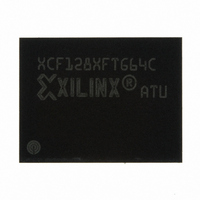XCF128XFTG64C Xilinx Inc, XCF128XFTG64C Datasheet - Page 25

XCF128XFTG64C
Manufacturer Part Number
XCF128XFTG64C
Description
IC PROM SRL 128M GATE 64-FTBGA
Manufacturer
Xilinx Inc
Datasheet
1.XCF128XFTG64C.pdf
(88 pages)
Specifications of XCF128XFTG64C
Memory Size
128Mb
Programmable Type
In System Programmable
Voltage - Supply
1.7 V ~ 2 V
Operating Temperature
-40°C ~ 85°C
Package / Case
64-TBGA
Access Time
85ns
Supply Voltage Range
1.7V To 2V
Memory Case Style
FTBGA
No. Of Pins
64
Operating Temperature Range
-40°C To +85°C
Svhc
No SVHC (15-Dec-2010)
Package /
RoHS Compliant
Lead Free Status / RoHS Status
Lead free / RoHS Compliant
Other names
122-1578
Available stocks
Company
Part Number
Manufacturer
Quantity
Price
Company:
Part Number:
XCF128XFTG64C
Manufacturer:
XILINX
Quantity:
319
Part Number:
XCF128XFTG64C
Manufacturer:
XILINX/赛灵思
Quantity:
20 000
Read Mode Select Bit (CR15)
The Read Select bit, CR15, is used to switch between
Asynchronous and Synchronous Read operations. When
this bit is set to ‘1’, read operations are asynchronous; when
set to ‘0’, read operations are synchronous.
Synchronous Burst Read is supported in both parameter
and main blocks and can be performed across banks.
On reset or power-up, the Read Select bit is set to ‘0’ for
synchronous access.
X-Latency Bits (CR13-CR11)
The X-Latency bits are used during Synchronous Read
operations to set the number of clock cycles between the
address being latched and the first data becoming available
(Figure
assume the values listed in
Table 13
into account the speed class of the device and the frequency
used to read the flash memory in synchronous mode.
Table 13: X-latency Settings
Wait Polarity Bit (CR10)
The Wait Polarity bit is used to set the polarity of the
READY_WAIT signal used in Synchronous Burst Read
mode (with CR4 = 0). During this mode, the READY_WAIT
signal indicates whether the data output is valid or a WAIT
state must be inserted.
When the Wait Polarity bit is at '0', the READY_WAIT signal
is active Low. When this bit is set to '1', the READY_WAIT
signal is active High.
The CR10 Configuration Register bit becomes “don't care” if
CR4 is set to ‘1’, in which case the READY_WAIT pin
behaves like a READY pin (default value).
Data Output Configuration Bit (CR9)
The Data Output Configuration bit is used to configure the
output to remain valid for either one or two clock cycles
during synchronous mode. When this bit is ‘0’, the output
data is valid for one clock cycle; when the bit is ‘1’, the
output data is valid for two clock cycles.
The Data Output Configuration must be configured using
the following condition:
DS617 (v3.0.1) January 07, 2010
Product Specification
t
K
30 MHz
40 MHz
54 MHz
> t
F
9). For correct operation the X-Latency bits can only
MAX
shows how to set the X-Latency parameter, taking
KQV
R
+ t
QVK_CPU
T
33 ns
25 ns
19 ns
K
min
Table 12, page
X-Latency min
26.
3
4
5
Platform Flash XL High-Density Configuration and Storage Device
www.xilinx.com
where:
If this condition is not satisfied, the Data Output
Configuration bit should be set to ‘1’ for two clock cycles
(Figure 9, page
Wait Configuration Bit (CR8)
The Wait Configuration bit is used to control the timing of
the READY_WAIT signal when configured as an output with
the Wait function (in Synchronous Burst Read mode).
When READY_WAIT is asserted, data is not valid; when
READY_WAIT is deasserted, data is valid.
When the Wait Configuration bit is Low (reset to ‘0’), the
READY_WAIT signal (configured as an output with the Wait
function) is asserted during the WAIT state. When the Wait
Configuration bit is High (set to ‘1’), the READY_WAIT
output pin is asserted one data cycle before the WAIT state.
Burst Type Bit (CR7)
The Burst Type bit determines the sequence of addresses
read during Synchronous Burst Read operations. This bit is
High (set to ‘1’) as the memory outputs from sequential
addresses only.
See
output from a given starting address in sequential mode.
Valid Clock Edge Bit (CR6)
The Valid Clock Edge bit (CR6) is used to configure the
active edge of the Clock (K) during synchronous read
operations. When this bit is Low (set to ‘0’), the falling edge
of the Clock is the active edge; when High (set to ‘1’), the
rising edge of the Clock is the active edge.
READY_WAIT Bit (CR4)
The READY_WAIT Configuration Register bit is a user-
configurable bit. The default value is ‘1’, where the
READY_WAIT signal is configured as an input with the
Ready function (CR4 = '1'). This particular configuration
allows the use of the READY_WAIT signal for handshaking
during the configuration sequence and during a Reset (RP)
pulse as the device holds the pin Low until the entire internal
configuration of the device finishes. With CR4 = 1, the
external pin can also be used by the end user to retrigger the
first address latching sequence (FALS), simply by applying a
High, a Low, and then a High pulse on the READY_WAIT
pin. See
When CR4 = '0', the READY_WAIT signal assumes the
standard WAIT functionality.
t
t
system CPU
t
K
KQV
Table 14, page
QVK_CPU
is the clock period
"First Address Latching Sequence," page
is the clock to data valid time.
is the data setup time required by the
28).
29, for the sequence of addresses
41.
25





















